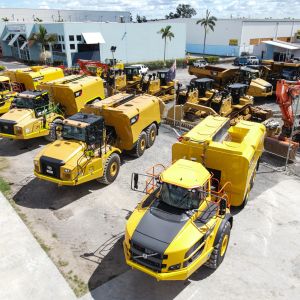Request the Best
The NSW WorkCover Position Paper on Quick Hitches for Excavators and Loaders takes effect on the 1st of May. For full details on the requirements click here. RD Williams recommends that when purchasing your new machine or replacing an existing hitch, you request the best, and insist on a Tefra quick coupler. Not all hitches are created equal, and whilst several brands will meet the WorkCover requirements, the below points should be considered when making your selection:
- No Swinging attachment – there is expected to be an amendment to the current standard within 12 months to add the requirement that both pins are fully enclosed so that the attachment can’t swing. Don’t get caught having to replace your new hitch when the change comes through.
- Does the Hitch Fail to Safe ? If Hydraulic power is lost in any situation, the secondary safety system should activate the hitch to lock the attachment on – from any failing position.
- Can the hitch only release using a Safe Detach Sequence ? If not, the operator can inadvertently release the attachment, which does not improve safety at all compared to the old requirements.
- Can the hitch accommodate Variations in Pin Centres ? Not all attachments are created identical and as a result, have pin centre variations. A quick hitch using a bar or hydraulic pin insertion design relies on the attachment having exactly the same pin centres as the hitch.
- How will you know if the hydraulics to the hitch has failed? Failure Indication is an essential safety feature.
There has been considerable misinformation about springs on quick hitches. All Quick Hitch designs include at least one spring somewhere to function, none of which are illegal, but utilise it in different ways. The Active Protection System on the Hills Tefra quick hitch is a fully Independent secondary locking system comprising two component parts. A coil spring around the cylinder ensures that the rear hook remains in the correct position in the event of a hydraulic failure. A leaf spring on the front hook acts to maintain it in the correct position in the event of a hydraulic failure. The springs do not take the weight of the attachment, this is done by the coupler hooks, the springs are there solely to keep the hooks correctly located . In addition, the pressure exerted by the springs provides a ‘Return to Safe’ feature ensuring that the hooks always remain in, or return to, the closed position. This combination of safety features is unique within the attachment industry and now provides excavator operators with the safest coupler on the market today.
RD Williams philosophy has always been to provide a quality product at Value for money prices. As far as we know, the Tefra hitches we provide is the only quick coupler that exceeds all current requirements and meets all the above criteria. In fact, the design is so clever that the manufacturer was just awarded “The Queens Award for Enterprise: Innovation”! The judges were particularly impressed with the quick hitch being so simple (only 3 moving parts, making it very reliable), yet revolutionalising the hydraulic hitch market with features taking it to a whole new level compared to existing offerings. So, request only the best, a Hills Tefra Quick Hitch!
A Super Pension Choice
No one seems to dispute that the current Pension system is unsustainable. But equally so, nobody wants to “lose out” by changing it. The “lose out” definition seems to be more about peer comparison and jealousy, than it does comparing to the current situation. As a society, we’ve become so accustomed to demanding compensation any time a rule changes adversely, which is why the tinkering at the edges approaches over the last few years has failed. What is needed is a full rethink.
Superannuation was supposed to replace the pension for most Australians. This isn’t working, because everyone is trying to get both “their” pension (4 out of 5 Australians over 65 receive a full or part pension), and keep their super income. So through tax planning, the “rich” collect pensions by using different schemes such as cashing in super at retirement or keeping their main asset (highly valued homes) outside the pension assessment criteria. The “poor” on the other hand prefer to spend all through their working lives (knowing they’ll get a pension) rather than save, only to fall short of enough money for a comfortable retirement.
So everyone is playing the system. The “smart” decide early whether to spend now (and hope the Government Pension system will be there for them), or make a go of saving so that they’ll have enough to self-fund retirement. The “foolish” (most of the population) get stuck in between. Which is why it is refreshing to hear the Australia Institute (sometimes referred to as the loony left-of-centre think tank) suggest a different approach: Raise the pension by 7.5%, and pay it to everyone. The kicker is to remove all other Superannuation tax concessions. This would make anyone who saves or makes investments able to spend it on whatever they like, whenever they like. With Superannuation tax concessions growing at 12 percent per year (compared to the age pension growing at 10%), the Federal Government would be better off too (the figures are rubbery, but estimated at about $35 billion per year, so a big difference).
My first reaction was that the idea was stupid. But then I realised that it is this kind of thinking that we need to start questioning the Status Quo. And who can argue that everyone receiving the same amount is unfair (except perhaps that some people contributed more or less in taxes to pay for it, but that applies to everything Government provides)? But of course we won’t have a mature discussion about “radical” ideas like this, because the $1.5 Trillion (and growing) Superannuation industry collects about $20 Billion in fees each year, and will fight any changes that reduce their market size. Since 1997, the Australian consumer financial services market has grown at ten times the rate of the population, largely on the back of compulsory super (now comprising half the financial services market). Of course, their market need not reduce in size (they just need to encourage people of the benefits of saving), but they’d need to start justifying their fee’s – and perhaps that’s hard? 1-2% (irrespective of balance) with no accountability for the results and for not really doing much at all. Alan Kohler recently suggested perhaps the Funds should be forced to invoice their customers for fee’s rather than automatically deduct it from the super account – it would highlight the fee’s to everyone, and maybe that’s a good start?
Society’s Hand Brakes
Vehicles continue to have better safety systems and our roads are progressively improving. Police enforcement is also increasing, particularly in the easy enforcement areas of speeding and drink driving (and increasingly Drug testing). This has kept the road toll fairly steady in recent years. The next area that needs to be addressed must be related to Society’s hand brakes. You know, the ones that hold everyone else back. For instance, during a recent country drive, we’d be driving in a nice 100km/h section in a long queue of vehicles stuck behind someone doing 80km/h. Technically, they are not doing anything illegal, or even dangerous. Until we hit the overtaking lane, and the same vehicle accelerates to 100km/h (or slightly more) until the lane finishes and they revert to toddling along at 80km/h again. Sometimes, they even occupy the right overtaking lane too. This selfish behaviour then “forces” others into dangerous behaviour. These hand brakes on society also take other forms, like texting at lights, hence missing the flow of traffic. Of course, they sneak through, but you don’t. So it is others that wear the consequences of their slowness and lack of presence in the moment.
Our roads would be much safer if we encouraged proper driver education, including compulsory collision avoidance training. Maybe then we could review the speed limits on our roads up from the current levels in line with the advances in road construction standards and vehicle technology. And those choosing not to be present whilst in the drivers’ seat can catch buses, planes or trains.
A Simple Health Review
How can we afford a quality Health system when the cost is increasing faster than taxes paid? Our Health system has complicated so many things that should be simple. For instance, there is a (complicated) calculator that compares an Average Hospital procedure in different states. In simple terms, the National Average is $860 per procedure. Federal Health Care funding is then based on the number of procedures times the National average. In Queensland, our average is about $1,200 per procedure, with the State Government having to fund the difference, that is about $340 per procedure. In Victoria many years ago, the Kennett Government reformed their Health services, and as a result, their average procedure now costs $600. For each procedure, Victoria therefore gets $260 extra in Federal Funding, which they can spend on whatever they like, because the system makes money for them. This funding model is a good idea in principal, as it presumes each State will try to improve their systems.
So why does it cost twice as much for a procedure in Qld compared to Victoria? I’ve given some examples in previous articles, but it would seem that it shouldn’t be particularly difficult to improve the Health Care in Qld without any increased cost whatsoever to the tax payers. So simply speaking, it may be healthy to learn half a thing from Victoria!?!
As always, onwards and upwards!
Fred Carlsson
General Manager



